#Westwood Gallery
Explore tagged Tumblr posts
Text

“Jeff Way In His Tribeca Loft”, 2023; “Turtle Owl Death Mask”,2018 and “Egyptian Violet Gorilla Mask”, 2017

Kimiko Fujimura “Party-3 (Party at Peter’s)", 1990, and “Kimiko Fujimura in her Chinatown Loft”, 2023
For his current exhibition, Loft Law, on view at Westwood Gallery, documentary photographer and filmmaker Joshua Charow photographed artists living and working in the remaining spaces still protected by Loft Law in NYC. The well-crafted portraits offer a chance to see how the artists have made these spaces home over the years.
The gallery has also included artwork by eleven of the artists featured in the photos- Carmen Cicero, Loretta Dunkelman, Betsy Kaufman, Kimiko Fujimura, Joseph Marioni, Carolyn Oberst, Marsha Pels, Gilda Pervin, Steve Silver, Mike Sullivan, and Jeff Way.
From the gallery-
In 1982, Article 7-C of the Multiple Dwelling Law, also known as the Loft Law, was passed in New York City. The law gave protection and rent stabilization to people living illegally in manufacturing and commercially zoned lofts. Hidden behind this legislation were thousands of artists who needed a live/work environment at an affordable rent. These artists protected by the Loft Law changed the trajectory of New York’s cultural landscape.
Three years ago, Charow found a map of the remaining buildings with Loft Law protection. He rang hundreds of doorbells to find and photograph over 75 Loft Law tenants across the city to document the last of these incredible spaces and the creative individuals who made them home. Charow’s interest in the Loft Law and the vanishing history of New York stemmed from his early teenage years when he became immersed in a subculture called ‘Urban Exploring,’ the practice of illegally climbing skyscrapers, bridges, and abandoned subway stations. One of the rooftops he visited was an old factory building in South Williamsburg, where a tenant explained to Charow about the building’s remaining tenants under Loft Law protection.
The photos are a living visual document of the expansive spaces: old flophouses on the Bowery, garment factories in Tribeca and SoHo, glass factories in Greenpoint, and even a former ice cream factory in DUMBO. From the 19th to the 20th century, many buildings in NYC, including SoHo, were manufacturing centers for items from sewing machines to textiles to printing houses. The massive light-filled loft spaces with high ceilings were left empty when these businesses vacated in the mid-1900s and moved to other areas outside of New York City. The industrial-zoned lofts were not legal to live in, as they did not meet the building requirements for residential use, and oftentimes were completely raw spaces without a kitchen, shower, plumbing, or even heat. However, artists were attracted to these large spaces where they could work and create at any hour of the day. At the end of the 1970s, loft living started gaining attention in the media and the wealthy started to become attracted to this lifestyle. Soon landlords began to evict the artist tenants in favor of a wealthier clientele. A group of artists formed the Lower Manhattan Loft Tenants and spent years lobbying in Albany to gain legal protections and rent stabilization. At the time the Loft Law was first passed, there were tens of thousands of artists living in lofts across the city. Today, only a few hundred artists protected under the original 1982 Loft Law remain. This exhibition marks one of the first documentary insights into this vanishing history.
The majority of Charow’s images depict painters, sculptors, photographers, musicians, and filmmakers captured amidst their industrial loft spaces. Notable portraits include experimental music and film artists Phillip (Phill) Niblock (1933-2024) and Katherine Liberovskaya (b. 1961); Phill was instrumental in the avant-garde music and film scene from the 1960s to the present. Visuals artists include 97-year-old abstract and figurative expressionist Carmen Cicero (b. 1926), who has works in the collections of the Guggenheim Museum, Museum of Modern Art, and Whitney Museum; Kimiko Fujimura (b. 1932), who in 1965 was selected as “Japan’s Top 5 Female Painters in Contemporary Art” by Geijutsu-Shincho, a Japanese monthly art magazine; minimalist painter Loretta Dunkelman (b. 1937), a co-founder of the all-female artists cooperative A.I.R. Gallery; and Gilda Pervin (b. 1933), whose studio occupies the top floor of a 1790s Quaker building linked to the Underground Railroad and happens to be the old studio space of famed sculptor Eva Hesse, who worked there from 1965-70. Also included is Chuck DeLaney, co-founder of the Lower Manhattan Loft Tenants, an early activist group that was responsible for the lobbying and passing of the Loft Law.
This exhibition closes on 7/13/24.
#Joshua Charow#Westwood Gallery#Art#NYC Art Shows#Photography#Art Shows#Kimiko Fujimura#Jeff Way#Artist Documentaries#Betsy Kaufman#Carmen Cicero#Carolyn Oberst#Documentary Photography#Gilda Pervin#Joseph Marioni#Loft Law#Lofts#Loretta Dunkelman#Marsha Pels#Mike Sullivan#Mixed Media Art#New York Art Shows#NYC Artists#NYC Tenant Law#Old New York#Painting#Sculpture#Steve Silver#Artist Housing
0 notes
Text




Leeds 🏴🇬🇧
#Leeds#Leeds art gallery#vivienne westwood#Victoria arcade#Victoria quarter#architecture#Victoria Leeds#Leeds city centre#Yorkshire#art gallery#gallery#art exhibition#art#dark academia#dark acadamia aesthetic#light acadamia aesthetic#light academia#art history#history of art#oil painting#painting#john atkinson grimshaw#Leeds bridge#retribution#Edward armitage#Leeds library#Leeds central library
29 notes
·
View notes
Text

Outfit Rundown: JSK, Knit, Socks, Headbow: Innocent World Boots: Artka Jewellery: Vintage, Omnia, Vivienne Westwood, Mill Foundry
Point of outfit: Wearing Mucha to see Mucha!
I went to see the Mucha Exhibition at the NSW Gallery today! It was beyond amazing and I spent a solid three hours exploring all the details of the prints, studies, photographs, and other pieces brought over for the exhibition.
When I found out about the exhibition, I knew I wanted to go, and that I wanted to wear this dress. It's been on my wishlist for a while, but was fairly low priority as I hadn't seen it in quite a while. I took on the quest to find it when I heard the exhibition was coming, and tracked down the 2011 pink on Closet Child.
It made the day that much more special! Rose from this series is featured on the advertising banners for the gallery, and a lot of people complimented the dress as I went through the gallery (and outside/nearby). It made what was already a special day even more wonderful.
The insane weather ruined my hair and exposed my bloomers to onlookers at Circular Quay, but not even that was enough to ruin the delight I had in seeing these pieces in person. I had the additional joy of introducing my partner to Mucha, which he knew the "influence" of, but not the source. He's now a huge fan!


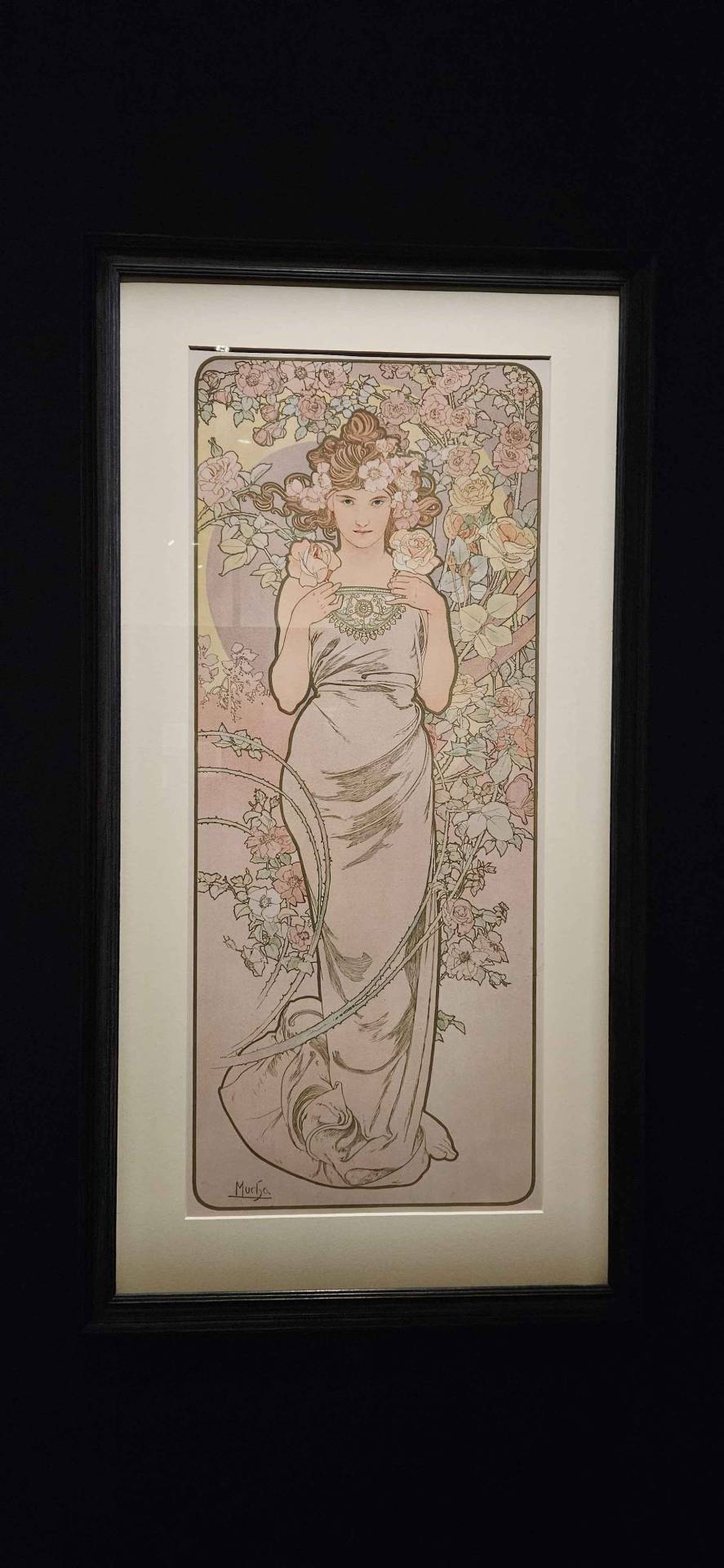

238 notes
·
View notes
Text

'bondage trousers + parachute shirt by vivienne westwood + malcolm mclaren, c. 1974-9' in fashion + textiles in the international collections of the national gallery of victoria - robyn healy (2003)
212 notes
·
View notes
Text
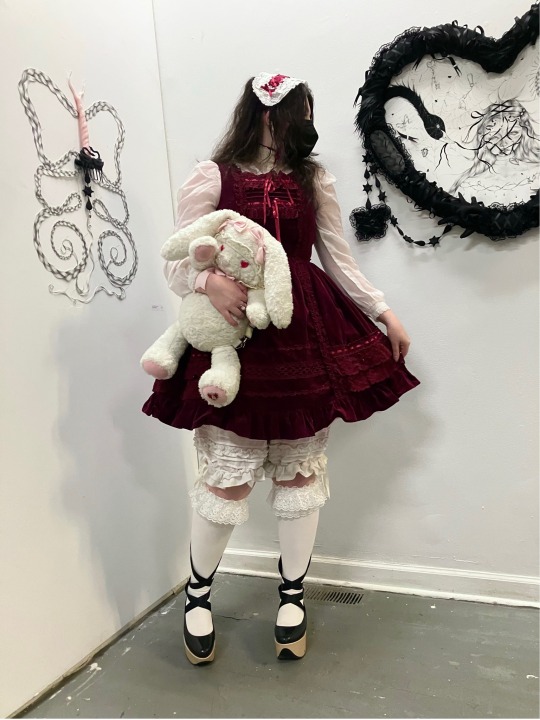
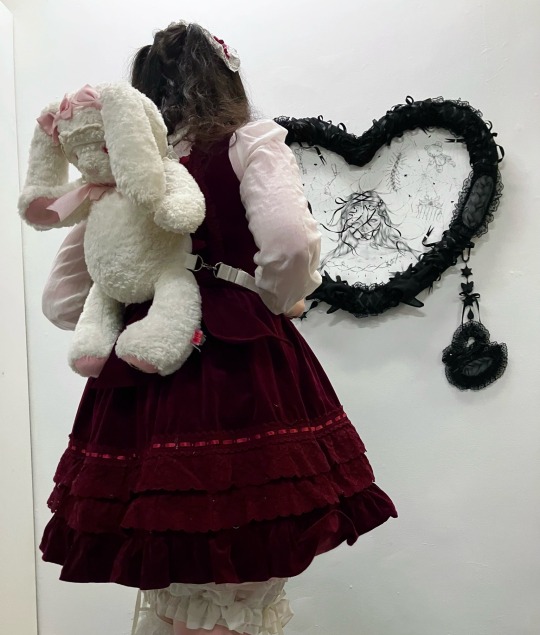


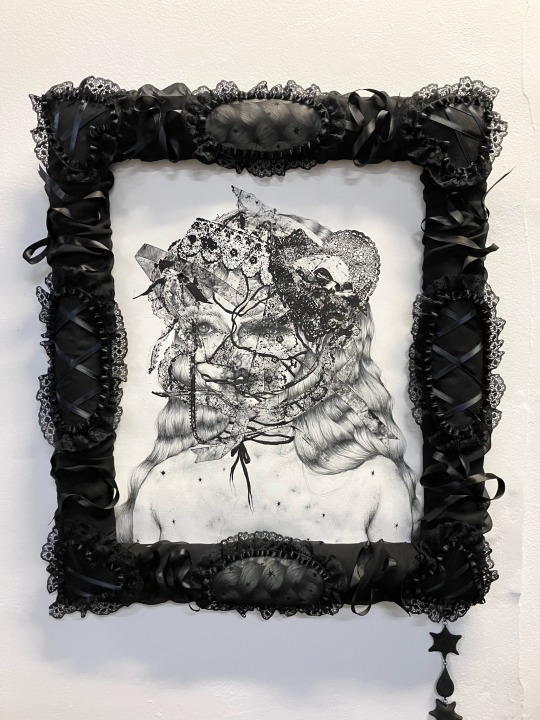
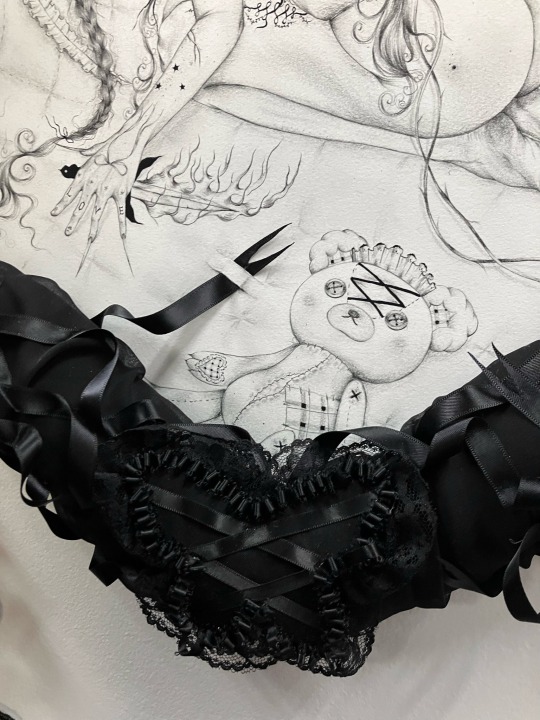

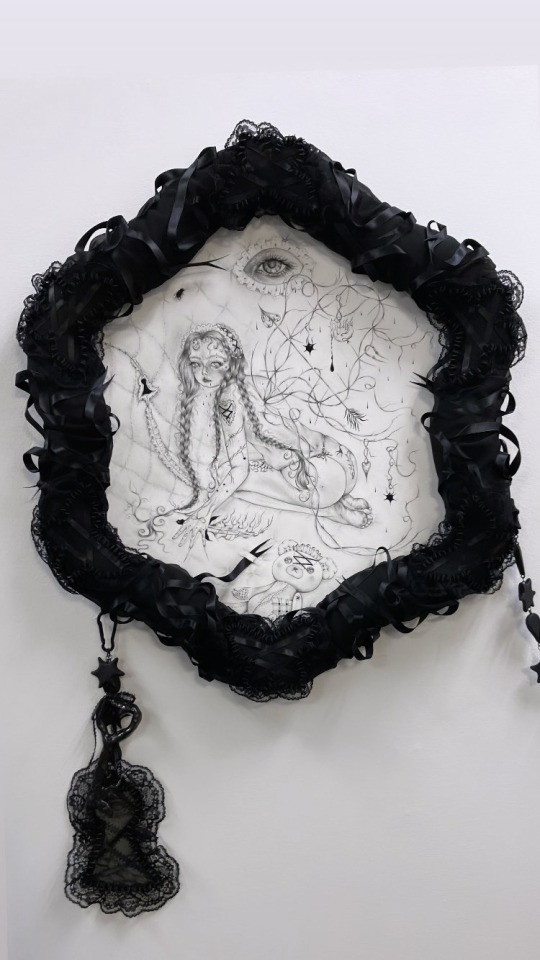
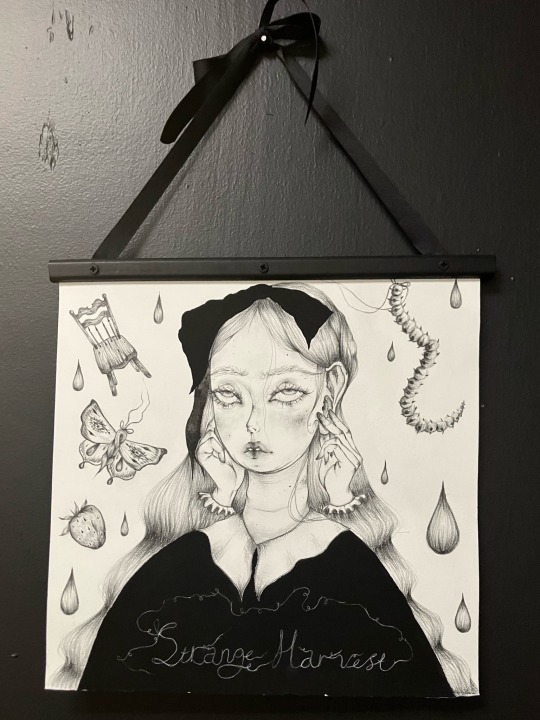
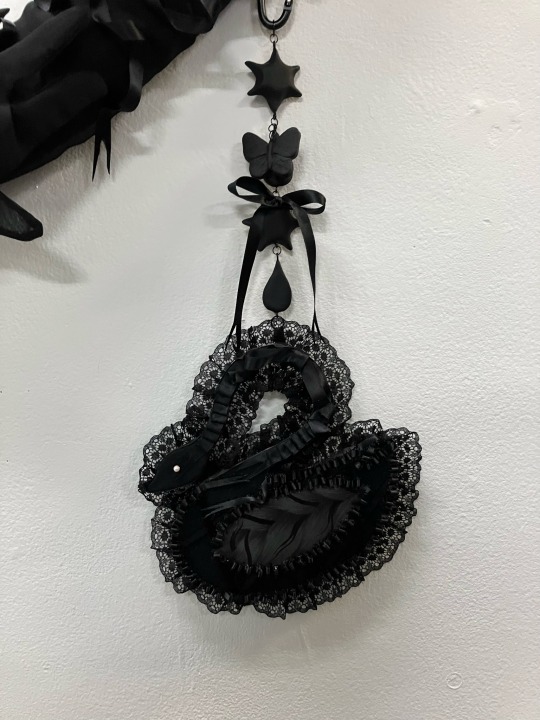
my friend and I went to the opening of Nicolette Lim’s show at Happy Gallery Chicago yesterday! Everything was so beautiful 🖤🥀
I love how three-dimensional the art pieces are and parts of the drawings/frames remind me a ton of lolita rectangle headdresses <3 This is the second show we’ve been to at this gallery and they’ve both been so cool!! The artist also does tattoos and has a tumblr blog @nicolettelim-tattoo
Coord rundown:
JSK: BTSSB Velveteen Frill JSK
Blouse: Gunne Sax
Bloomers: Fan+Friend
OTKs: Metamorphose
Headdress: unknown
Shoes: Vivienne Westwood
Usakumya: BTSSB ૮꒰ ˶• ༝ •˶꒱ა ♡
#lolita fashion#oldschool lolita#baby the stars shine bright#usakumya#classic lolita#egl fashion#I would love stickers of the different art pieces/tattoo flashes… there were prints for sale but I have nowhere to hang prints :(#I have more pics of this coord too that we took outside#sadly we arrived late and missed the cake but it looked really good#I love this dress it was so fun to wear#and nice to give usakumya an outing#sadly the shoes aren’t mine but I ordered a pair from antaina that should arrive… eventually#can’t wait I love rocking horse shoes so much#mine
173 notes
·
View notes
Note
hey girl how was your travels?? we need an update!!!
my travels were GREAT !!!!!!!! i went to new zealand, first to auckland and stayed in ponsonby literally because a band lived there 😅 but the place i stayed at had kittens and three very sweet dogs so it was great !!! the food was delicious, coffee was great. went to a really fancy birthday for a late birthday present and ughhhh the experience was incredible !!!!
i went down to hamilton next, this was mostly so i could go to te awamutu, home of the finn brothers, but hamitlon was good fun! had some good pizza and watched how to lose a guy in 10 days, can't complain! <3 anyway te awamutu was so much fun !!! they had a rose garden with the most gorgeous roses! went to the museum for the finn brothers exhibition and geeked out a little too hard with the woman behind the counter [sorry belinda!!]
then i went down to palmerston north to visit a friend! and it was a lot of fun!! had a shopping plaza, had the BEST french toast there, and i went to the library and art gallery to have a look around. very chill time there.
and then WELLINGTON !!! where i had the most fun ! i stayed with a friend and it was the best! we went to the vivenne westwood exhibit they have over there, saw some amazing jewellery ! went to the zoo !! saw some pretty meerkats ! also went to wildlife park and nearly died because of birds </3 BUT i made friends with some piggies so it was great fun !!!!!! honestly this trip was pretty cool !
#ask#earthandsunandmoon#and the weather was beautiful every day#i was like oh i wont need shorts because nz is already a bit cold... i was debating whether to buy some within the first three days
16 notes
·
View notes
Text
HUgE Dec 2010
STARSHIP AND CANOE
Wearing heavy knitwear, tweeds and blankets, they set out into uncharted territory, with a tough, rebellious spirit.


Trove knit cardigan ¥27,300 (Trove)
《Wiz&Witch》 cut and sew ¥16,800 (CULTIYEAR)
Tweed pants by Frank Leder ¥45,150 (MACH55 Ltd.)


Trove knit cardigan ¥27,300 (Trove)
《Wiz&Witch》 cut and sew ¥16,800 (CULTIYEAR)
Tweed pants by Frank Leder ¥45,150 (MACH55 Ltd.)

Harapos Reales V-neck cardigan ¥81,900 (THIS TIME inc.)
Dsquared denim pants ¥58,800 (Kokonoe)
Missoni socks, ¥6,300 (Onward Kashiyama Customer Service Center) Sneakers, personal belongings

Yaeca layered coat ¥77,700, cut and sew all-in-one ¥19,950 (both Yaeca) Missoni socks ¥6,300 (Onward Kashiyama Customer Service Center) Beth boots ¥82,950 (The Wall Showroom)

Hooded cardigan by THE INOUE BROTHERS ¥93,450 (International Gallery BEAMS) Wool wide pants by White Mountaineering ¥28,350 (White Mountaineering) Socks by Missoni ¥6,300 (Onward Kashiyama Customer Service Center) Boots by Beth ¥82,950 (The Wall Showroom)

Missoni knit duffle coat ¥315,000 (Onward Kashiyama Customer Service Center)


Baggy stole from Mountain Research ¥44,100 (..... Research GENERAL STORE)
Vivienne Westwood Man denim pants ¥39,900 (Vivienne Westwood Information)
The vintage blanket worn underneath is ¥39,900, and the used sneakers are ¥9,660 (both JANTIQUES)
#my scans#fashion#avantgarde#2010s fashion#archive fashion#japanese fashion#vivienne westwood#white mountaineering#missoni#dsquared²#dsquared2#tweed#knitwear
19 notes
·
View notes
Text

MAJOR BLACKOUT IN VIEVECOR CITY!
As the sun sets in Vievecor City and its residents are winding down for the day, various parts of the city are suddenly plunged into darkness when the clock strikes 9pm!
Large blocks in each district have lost power in what is later found to be a coordinated attack to the city's power grid. None of these establishments were able to have power returned to them until the sun rose the next day.
What is curious and frustrating for the supernatural community to realise is that the places that have lost power were strategically chosen...
The following buildings/establishments and its surrounding buildings have had their power shut down:
The Shard 🔥🎯
Remington Tower 🔥🎯
Effendi Plaza 🎯
Nevermore Bar & Grill 🔥
Lunar Heights Pub 🔥
The Hereafter 🔥🎯
Westwood Theatre 🔥
Punch Cage 🔥
Vievecor City Gallery 🎯
Ware 🔥
With the power outtage at these specific establishments comes what the supernatural community knew innately was soon going to happen.
Attacks.
Groups of individuals were witnessed taking advantage of the chaos to vandalise (🎯) and/or set fires (🔥) to the supernatural-owned buildings. The places that were vandalised (🎯) will find an green-coloured illusion of Artemis' hunter's mark floating outside their building for 24 hours...
The following district has had its power shut down:
Chissob Hills
The entire district of Chissob Hills was plunged into darkness on this night. Despite dealing with a power outage in their own district, the Police and Fire departments were also busy dealing with the blackouts around the city and it stretched them and the Lycaon pack too thin. Vievecor City was lucky that Zamok Penitentiary was put on lockdown once the blackout occurred and no prisoners were reported to have escaped...
Amidst the chaos at Chissob Hills, ZACHARIAH REMINGTON was found to have escaped incarceration under the Lycaon pack. He was known to be aided by a group of Artemis followers because ONE FOLLOWER was captured in the aftermath. This one follower had a familiar object on their person -- a beaded bracelet that has been imbued with protective magic...
How will the supernatural community deal with this blackout? How are they going to go forward?
OOC Info:
Happy Blackout Chaos~ 🎉 Players should use the information in this PLOT DROP post to plot/discuss how their characters are involved with this blackout. Remember in which districts your characters reside/work in. Where were they when this blackout happened? What are they going to do? Did they witness any attacks? How will they deal with them while also abiding by the Golden Rule? As shown by the legend above, the different establishments have been either vandalised or set on fire or both. How will the owner's of these establishments deal with this and the mark that will remain outside their establishment for 24 hours? For IC-knowledge, humans will definitely be able to see these and characters should find ways to explain them away. Players can feel free to chase away, subdue or kill NPCs they have created for this plot drop, but please let the mod know of your plans and that any fallout from the Golden Rule and Council decisions must be played out! NPCs can be Artemis followers OR they can also just be regular humans taking advantage of the blackouts to cause some chaos! Establishments with the 🎯symbol are more likely to have been the target of Artemis attacks. Establishments with only the 🔥 symbol would more likely have been trashed and looted by humans who are not Artemis followers. The only NPC with any substantial knowledge will be the one mentioned in the post above! Every other NPC will not be able to give anyone much knowledge about Artemis that is not already known... HAPPY PLOTTING~
4 notes
·
View notes
Text
hhh i wanna draw a new intermission lucas & claus ref for artfight too, i hate how their best ref is art from before i enbroadened them. narrow westwood twins arent real they cant hurt you my therapist tells me but theyre there in the corners of their artfight galleries. staring back at me. brittle-boned and malnourished.
14 notes
·
View notes
Text

Westwood Gallery
14 notes
·
View notes
Text
✨🔨✨
54 notes
·
View notes
Text
20 Most Popular Neighborhoods to Live in Los Angeles in 2025
Los Angeles, a city where diverse culture, rich history, and constant innovation converge, continues to captivate new residents with its ever-evolving neighborhoods. As we move toward 2025, the top LA neighborhoods reflect a blend of artistic hubs, luxurious enclaves, and family-friendly communities, each embodying the city's dynamic energy. Whether you’re drawn to trendy urban areas, serene residential zones, or vibrant arts districts, LA offers something for everyone.
Here’s a snapshot of the 20 most popular LA neighborhoods in 2025:

20. Baldwin Hills With panoramic city views and classic mid-century homes, Baldwin Hills balances a rich cultural history with modern community amenities. Outdoor lovers enjoy access to Kenneth Hahn State Recreation Area, which offers scenic hiking trails and family-friendly picnic spots.
19. Hollywood Beyond its iconic status, Hollywood offers diverse living, from historic bungalows to modern apartments. The neighborhood seamlessly combines world-renowned entertainment landmarks with quieter residential streets, ideal for those seeking a blend of excitement and relaxation.
18. Eagle Rock Known for its craftsman homes and creative energy, Eagle Rock appeals to families, artists, and students alike. Indie boutiques and artisan cafes reflect its bohemian spirit, while Occidental College adds an academic touch.
17. Mar Vista Mar Vista combines a coastal feel with a suburban vibe. Known for its farmers’ markets, local cafes, and community parks, it’s perfect for families and those wanting easy access to both city life and the beach without the crowds.
16. Hancock Park Famed for its historic charm, Hancock Park attracts families and professionals who appreciate its stately homes and tree-lined streets. The neighborhood offers classic LA luxury with community-centered living.
15. Downtown Los Angeles (DTLA) DTLA has transformed into a cultural and residential hub, offering high-rise apartments, historic lofts, and landmarks like The Broad Museum. It’s a thriving urban center where professionals and retirees can experience city life with cultural depth.
14. Koreatown (K-Town) Known for its lively food scene and vibrant nightlife, Koreatown offers urban living at an affordable price. High-rise apartments and cultural hotspots make it popular with young professionals and families seeking city life with character.
13. Sherman Oaks Sherman Oaks strikes a balance between suburban living and city amenities. Spacious homes, reputable schools, and Ventura Boulevard’s dining and shopping make it ideal for families who appreciate a lively yet relaxed atmosphere.
12. Echo Park Echo Park’s bohemian energy and diverse community appeal to artists and creatives. Home to indie music venues, unique shops, and the popular Echo Park Lake, this neighborhood blends urban excitement with laid-back charm.
11. Playa Vista Nicknamed "Silicon Beach," Playa Vista is a tech hub where modern residences and shared green spaces draw professionals and families alike. The neighborhood’s parks, shops, and events foster a balanced, community-oriented lifestyle.
10. Culver City A former film studio hub, Culver City has transformed into a tech and arts district. With theaters, art galleries, and vibrant restaurants, it’s perfect for professionals and creatives seeking a neighborhood with history and innovation.
9. Pasadena Historic Pasadena offers a vibrant mix of culture and community, from the annual Rose Parade to attractions like the Norton Simon Museum. Old Town Pasadena adds a modern touch, attracting both families and professionals.
8. Westwood Home to UCLA, Westwood is a blend of academic energy and residential charm. Historic theaters and local eateries, along with proximity to major business hubs, make it appealing to students, professionals, and families.
7. Silver Lake Eclectic and progressive, Silver Lake draws artists and young professionals with its indie venues, murals, and the scenic reservoir. The neighborhood’s blend of modern and historic homes fosters a trendsetting yet grounded community.
6. Arts District Once an industrial zone, the Arts District is now a vibrant urban neighborhood where repurposed warehouses house chic lofts, art galleries, and indie boutiques. Artists, entrepreneurs, and professionals flock here for its creative energy and unique blend of work and play.
5. Beverly Grove Anchored by The Grove and the Original Farmers Market, Beverly Grove is a hotspot for shopping, dining, and culture. Its proximity to LACMA and chic eateries makes it a lively, urban destination for families and professionals.
4. Hollywood Hills Offering a luxurious retreat with stunning city views, Hollywood Hills is ideal for high-profile residents seeking privacy. With access to nearby hiking trails and nightlife, it’s a favorite among those who value both serenity and proximity to action.
3. Brentwood With tree-lined streets, spacious homes, and a relaxed, upscale vibe, Brentwood is ideal for families. Its boutique shops, farmers’ market, and proximity to the coast combine to offer a refined and active lifestyle.
2. Venice Venice’s mix of artistic flair and beach vibes makes it popular with creatives and entrepreneurs. Known for its iconic boardwalk, Venice Canals, and innovative Abbot Kinney Boulevard, it combines relaxed beach living with a lively cultural atmosphere.
1. Bel Air Nestled in the Santa Monica Mountains, Bel Air is synonymous with luxury and exclusivity. Known for its grand estates and gated properties, it’s ideal for those seeking privacy with easy access to Beverly Hills’ amenities.
Los Angeles in 2025
As LA continues to grow and diversify, its neighborhoods reflect a city that embraces both tradition and modernity. From artsy, progressive communities to tranquil luxury enclaves, there’s a place for every lifestyle. Discover your ideal LA neighborhood and experience a city that celebrates heritage, innovation, and inclusivity.
#ADULosAngeles#California#Californiainvestors#FreePropertyReport#InvestInProperty#investors#LandDevelopment#Losangeles#Losangelesca#Losangelesinvestors#LosAngelesRealEstate#PropertyInvestment#PropertyValue#Realestate#RealEstateDevelopment#RealEstateInvesting#RealEstateOpportunities#Realtors#Terrakan#Terrakanaddress#UnlockPotential#RealEstateTips#HomeBuyingAdvice#PropertyReports#RealEstate#BuyerBeware#DualAgency#ZoningIssues#HiddenCosts#Homeownership
2 notes
·
View notes
Text
Exhibition Review: Women in Revolt! Art and Activism in the UK 1970-1990

Anything feminist puts me instantly on guard. Feminism sells. Sure. But can't female artists be recognised for anything other than having a vagina? Female artists in Britain did not occupy the spaces of museums and galleries, their work has been safeguarded under individual mattresses and home archives. So I approached Tate Britain's exhibition with a certain scepticism, wondering if the show would be a tokenistic gesture of promoting ‘inclusivity’.
From the get-go, there is one thing obvious. There are no Guerrilla Girls. There are no Mona Lisas. Each piece, interdependent, brings dimension to all the contradictions and experiences of women at a time of significant sociopolitical change. As a result, the exhibition is messy and fatiguing; it almost tries too much at once. However, this is no sign of failure, there is a feminist, non-capitalist politics which informs the curation of the exhibition. Women in Revolt! Art and Activism in the UK 1970-1990 showcases the works of over 100 female artists who used their work to campaign for women’s rights and whose contribution to British culture has been incredibly uncredited.
Arranged chronologically, the exhibition begins with photographs taken by then-20-year-old Chandon Fraser of the First Women’s Liberation Conference that took place in Oxford. Unlike images of any male gathering, these images are intimate, women are smiling and some carrying their infants with them. These women are wives, mothers, activists and artists all carrying the burden of being a woman in each role. Maureen Scott's painting Mother and Child at Breaking Point supplies an honest reflection on being a devoted mother and at the same time, losing the sense of ‘I’. Or, Susan Hiller's "10 Months," where she documents her growing pregnant belly through photographs, along with text from her journal where she writes about being a woman artist. At the time, being a female artist and a mother were considered incompatible. These works demonstrate that while society accepts that there are good, bad, and they-went-to-buy-milk-they-said fathers, mothers are held to different standards.
The works are witty and thought provoking, for instance, Monica SJOOS referencing phallic culture with a painting of a big penis overcasting a city or Rose Finn-Kelcey's 'The Divided Self' a self-portrait of her sitting on a bench at Hyde Park, bookended, appearing on opposite sides of the bench in conversation with her 'other' self. The photograph examines the dichotomy between the person we are in private and the person we are in public.
The exhibition also recognises the influence of subcultures in their role of pushing the boundaries behind the theatrics of womanhood. In the 1980s, against London's depressive political backdrop, a bunch of working-class teenagers were determined to build their own swinging London and escape into an electric new counterculture. These kids would gather around cubs like Blitz's which made the ultimate test bed for new romantics, punks, fashion and lesbian squatters. The photographs by Jill Posner of lesbian couples inhabiting new places were a way to challenge traditional female beauty canons aimed at male arousal and defy sexual orientation attitudes. While others such as Jill Westwood’s photographs of her wearing a latex outfit or Liz Rideal’s self-portraits of her face in a photo booth as she reaches orgasm would use hyper-sexualisation as a means of declaring control over their bodies and acknowledging their sexual self.
It becomes evident that women produced work on the fringes of the art industry, creating their magazines, putting shows at alternative venues and sustaining their work through collaboration. The postal art project supported by Monica Ross and Su Richardson is an example of the networks women built to disseminate their work. These works included in the exhibition are small-scale pieces of artwork using DIY techniques that women would produce on kitchen counters with random items found in the house. These collectibles were mailed between women creating documentation of their experiences. Forms of low-status art became a significant medium of feminist art, which is a direct reflection of women's precarious material conditions at the time.
The exhibition does not focus on a universal experience of women, each room has the function to provide a new layer to the narrative of feminism activism in Britain. Marlene Smiths' “My mother opens the door at 7 am. She is not bulletproof” a portrait of Dorothy Cherry Grace who was shot at her home in Brixton documents the BLK Art Group's contribution to feminist activism and racism in Britain.
Turning our view back to the present, what does it all mean? Perhaps this is the most important. One cannot stop themselves from making connections between women’s rights then and now. Abortion is being criminalised in my countries disowning women from their bodies, women are still inflicted between becoming a mother and pursuing their careers, walking alone at night is still dangerous, and social media algorithms have taken a role in exposing young minds to figures such as Andrew Tate and their “toxic masculinity” content. But at the same time, I wouldn’t want to live anywhere else in time but now.
I’ve confessed to myself that I am not a feminist of my time, as a young woman I’ve become weary of the term. Women In Revolt has put into question why I refuse to recognise this history of my gender when it means everything I take for granted now. Despite my initial judgements, this exhibition is a revelation.
#feminism#art#art exhibition#tate britain#archive of women artists#female artists#british art#exhibition review
3 notes
·
View notes
Text

◆FUZZI(フッジ)10%OFF優待参加◆ 開催期間:3月28(木)から31(日)まで 開催場所:Gallery なんばCITY本館1階店 上記期間、FUZZIが10%OFF優待に参加。 国内に1点物の商品を多数揃え、厳選された商品ばかりです。 ブランドの真骨頂に達している珠玉の作品を御覧頂けます。 国内と直接取引は数年のみ。 日本撤退の為、実際に現物を御覧・御試着頂けるのはおそらく当店のみです。 ジャンポール ゴルチェのソフトチュールファンの方は是非この機会に御買い求め下さい。 是非この機会にGalleryなんばCITY店をご利用下さい。 スタッフ一同、心よりお待ちしております。 【ブランド解説】 『フッジ(FUZZI)』社は元来、1954年にアデル バッチアーニ フッジによって設立されたイタリアのニット、カットソーメーカーでした。 1971年に��のアンナ マリア フッジに事業に参加し、1983年にはジャンポール ゴルチェとライセンス契約が交わされました。 1985年にはファッションデザイナーのジャンポール ゴルチェと共にマドンナのツアー衣装を手掛ける様になりました。 それはやがて1990年の『ブロンド アンビション ツアー』で結実し、ローリング ストーン誌を以って「精巧に作り上げられたセクシャルで挑発的な狂想曲」と評されました。 このトップモードによる巨大なエンターテインメントは「1990年で最高のコンサートツアー」として認知され、その後のマドンナのイメージを決定づけました。 フッジはゴルチェとのコラボレーション以後、多くのトップブランドのライセンス契約、コラボレーションを実現し続けています。 ライセンス契約ではモスキーノ、マルタン マルジェラ、ヒューゴ ボス、ロメオ ジリ、アズティン アライア等です。 サンプル制作に始まり、製品までコラボレーションするブランドではカナダ グース、エミリオ プッチ、エルメス等ヨーロッパのトップブランドの名が連なっています。 社の持つ40,000以上の過去のアーカイヴを基に自社の名前を掲げたブランド、『フッジ(FUZZI)』も設立されています。 ゴルチェの代表作の一つにソフトチュールシリーズがあります。 ソフトチュールシリーズは薄く伸びるレースの上に鮮やかなプリントを全面に施されていました。 通常、ソフトチュールはレース構造なのでプリントが定着しにくく、柄を表現しにくい素材でした。 しかし、それが高度な技術のプリントによって実現すると、ゴルチェはこの素材を最大限に活用しました。 人間本来の肉体を尊重するこのデザイナーはボディにフィットするソフトチュールに世界中のタトゥー、陰影の美しいギリシャ彫像、ポップアートから名画までをプリントしました。 まるで着用した者の肉体そのものが、別の種族、性別、素材へと変化した第二の肌の様でした。 また軽く、透ける特性のソフトチュールはゆったりとしたシルエットにしても今までにない視覚効果をもたらせました。 ギリシャの遺跡のひび割れた石柱、ドラマティックな表情の聖人、重厚な甲冑等が綿密なタッチで大きく描かれてそれがモデルが歩く度に軽やかに揺れる様子はユーモアであり、アートでもあります。全ては軽量で、ストレッチ性があり、着ていてストレスを感じることはないでしょう。 透け感のある素材は軽やかさを表現し、清涼感があります。 FUZZI社製の全面プリントソフトチュール作品。 ゴルチェのソフトチュールファンにとってはこれ以上のリバイバル品はございません。 Galleryでは、フッジの至高の世界観���余すこと無く御見せ致します。 -------------------- ◆10%OFF優待 招待状◆ 場所:Gallery なんばCITY本館1階店 【2024年度 最初の10%OFF優待】【春物出揃いました】 皆様の日頃の御愛顧に感謝を込めて3月28(木)から31(日)まで、「Gallery 全品10%OFF 優待」を開催。 Vivienne Westwood 2024年春物最新作や雑貨をはじめ、その他の全ブランド除外品無し。 この期間のみ店頭表示価格より10%OFF。 通常セール対象外のVivienne Westwoodの腕時計、財布、コインケース、シガレットケース、携帯灰皿、ライター、ZIPPOライター、ベルト、靴、雨傘、日傘、帽子、ストール等の小物類が全品10%OFFで御購入頂けます。 既に70%OFF等のSALE商品や普段SALEにならない商品も期間中のみ更に10%OFF。 御支払い方法は一切問いません。 現金、カード分割払い、シティ・パークス共通ショッピング チケット、ポイント利用、ギフト券併用 等、選択自由。 (但し、御取り置きの内金、既に御取り置き頂いている商品の御精算、修理代、通販は10%OFF対象外) パリ、ミラノ、ロンドン、ベルリン、ニューヨークからレディス・メンズ共に30ブランドの春物厳選200点以上入荷。 2024年春夏物最新作も全て10%OFFになるのは業界でもレアケースです。 【ヴィヴィアン ウエストウッド 腕時計在庫限り】 ヴィヴィアン ウエストウッドの腕時計は国内メーカーが生産終了、さらにメーカー側に在庫ゼロの為、弊社は現在の在庫が無くなり次第販売終了となります。 腕時計は再生産・再入荷・新規入荷の予定も御座いません。 国内ラスト1点のモデルも多数店頭に揃えております。 ヴィヴィアンの腕時計の購入を今迄、御検討されていた方はこの機会に是非、御決断下さい。 【artherapie 新作ネオドラゴン】 artherapie(アルセラピィ)から進化したドラゴンシリーズ、Neo DRAGON(ネオ ドラゴン)の長札財布がリリースしました。 型押しの精度が高められ、より迫力のあるドラゴンになりました。 さらに、ドラゴン部分に陰影を付け、定着に時間を掛け、立体感を出すことにベストを尽くしています。 ジャンポール ゴルチェのドラゴンと全く同じ職人と生産背景で製作しております。 特にこの水準の盛り上げ加工が出来る職人は国内に3人しかいません。その為、希少数しか生産出来ません。 一旦完売すると、約8ヶ月待ちになる為、是非この機会に御検討下さい。 ※期間中一般の御客様には店頭表示価格のまま販売しておりますので、必ずこの御招待状をスタッフに御提示下さい。御連れ様も一緒に御利用頂けます。 (御提示の無い場��は10%OFFになりません)、通販は対象外。 ※この優待セールはGalleryが独自に行っているもので、なんばCITY主催ではありません。くれぐれも御間違えのない様御願いします。 ※期間中の精算は全てポイント加算対象です。 ※他の割引サービスとの併用は出来ません。 ※ポイント10倍イベントより遥かに御得です。 ※店頭にこの優待のPOPや案内は掲示していませんので御注意下さい。 Gallery なんばCITY本館1F階店 〒542-0076 大阪府大阪市中央区難波5-1-60なんばCITY本館1階 【営業時間】11:00~21:00 【休館日】3月無休 【PHONE】06-6644-2526 【e-mail】[email protected] 【なんばCITY店Facebook】https://goo.gl/qYXf6I 【ゴルチェ派Facebook】https://goo.gl/EVY9fs 【tumblr.】https://gallerynamba.tumblr.com/ 【instagram】http://instagram.com/gallery_jpg 【Twitter】https://twitter.com/gallery_jpg_vw 【Blog】http://ameblo.jp/gallery-jpg/ 【online shop】http://gallery-jpg.com/
#FUZZI#フッジ#ジャンポールゴルチェ#jeanpaulgaultier#ソフトチュール#パワーネット#カットソー#ドレス#DRESS#ワンピース#プリントドレス#プリントワンピース#タイトドレス#タイトワンピース#リブニット#ボディコンシャス#プリントカットソー#プリントスカート#タイトスカート#タイトシルエット#ニット#セーター#リブニットセーター#ブラックドレス#パーティードレス#パーティーワンピース#長袖ドレス#長袖ワンピース#大阪セレクトショップ#なんばセレクトショップ
4 notes
·
View notes
Text



CROCUS - ART GALLERY
A new gallery has opened it's doors in the cities favourite art district, Garond. This new space will celebrate and lift up the diverse community of artists that Vievecor City has to offer. The space will be used for independent and up and coming artists in the city.
Regular exhibitions will be run, changing from month to month with a new artist taking up residency in the Crocus Art Gallery space.
Owner: Atlas Westwood Location: Garond
Jobs:
(1/1) Owner - Atlas Westwood (@atlaswestwood) (0/1) Art Curator (0/2) Security
( @vievecorcitylocations )
5 notes
·
View notes
Text
เปิดตำนานตุ๊กตาบลายธ์ (Blythe) สาวน้อยผู้ไม่เคยตาย
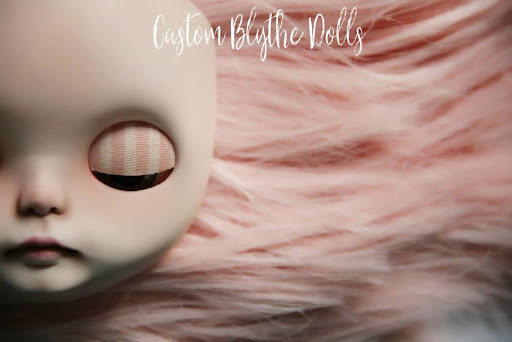
Blythe หรือ “บลายธ์” ยุคแรกถูกออกแบบและวางจำหน่ายในปี 1972 (พ.ศ.2515) โดยโรงงานผลิตของเล่น Kenner ในสหรัฐฯ ได้ว่าจ้างนักออกแบบของเล่นคือ Allison Katzman จาก Marvin Glass & Associates หนึ่งในสตูดิโอออกแบบของเล่นที่มีชื่อเสียงให้ออกแบบของเล่นเป็นตุ๊กตาเด็กผู้หญิงตาโต ซึ่งแต่งตัวทำผมได้ และมีเอกลักษณ์ความแตกต่างออกมาเป็น 4 แบบ ชื่อ Blythe, Karess, Willow และ Skye ซึ่งแต่ละตัวมีทรงผมยอดฮิตในยุค 70’s ต่างทรงกันไป และแต่งตัวไม่เหมือนกัน มีเสื้อผ้าให้เลือก 12 ชุดซึ่งจะสลับจัดชุดเปลี่ยนกันไปมาได้ตามประสาสาวน้อยแต่งตัวเก่ง
การโปรโมตบลายธ์นั้นลงทุนถึงขนาดใช้โฆษณาโทรทัศน์ ชูจุดเด่นที่เปลี่ยนสีตาได้ 4 สี เขียว ชมพู ส้ม และน้ำเงิน โดยดึงห่วงที่อยู่หลังศีรษะ แถมเพิ่มเทคนิคด้วยการให้ตุ๊กตามองซ้าย มองขวา มองตรงได้ด้วยการกระตุกเชือก แต่ว่าจุดเด่นกลับกลายเป็นจุดตายเมื่อเด็กๆ กลัวสีตาที่แปลกประหลาด บลายธ์รุ่นดั้งเดิมนี้จึงล้มเหลวทางยอดขาย กลายเป็นสินค้าลดราคาล้างสต๊อกเหลือแค่ตัวละ 3.5 เหรียญสหรัฐ ต่อมาก็ถูกเหมาถูกๆไปเป็นของแถมพ่วงตุ๊กตาตัวอื่น และในที่สุดก็ต้องหยุดขายและปิดโรงงานลงในระยะเวลาแค่ 1 ปีหลังเปิดตัวเท่านั้น
แต่ในปี 2001 หรือ 30 ปีต่อมา น้องบลายธ์ก็กลับมาเปิดใหม่อีกครั้ง เพราะมีหญิงสาวสาวชาวอเมริกันโปรดิวเซอร์รายการทีวีที่ชื่อ Gina Garan ได้ตุ๊กตาบลายธ์เป็นของขวัญจากเพื่อนแล้วเกิดหลงใหลน้องบลายธ์จนถึงกับพาเดินทางไปยังสถานที่ท่องเที่ยวรอบโลกด้วยกัน ตลอดทางนั้นก็ให้น้องบลายธ์เป็นนางแบบให้เธอหัดถ่ายรูปเก็บไว้กว่า 100 รูปแล้วนำมารวมเล่มตีพิมพ์เป็นหนังสือ “This is Blythe” สวยน่ารักจนสร้างเซอร์ไพรส์ขายได้กว่าหมื่นเล่ม ต่อด้วยการจัดนิทรรศการแสดงภาพถ่ายที่ส่งให้ Gina’s Gallery โด่งดัง
หลังจากนั้น Gina กับโปรดิวเซอร์ชาวญี่ปุ่นชื่อ Junko Wong ได้ร่วมกันจัดนิทรรศการเกี่ยวกับ Blythe ขึ้นหลายครั้ง เป็นที่สนใจของวงการแฟชั่น แต่ละงานมีดีไซเนอร์ฝีมือดีของห้องเสื้อแบรนด์เนมดังจากทั่วโลกไม่ว่า Prada, Gucci, Vivienne Westwood, Issey Miyake, Versace และอีกมากมายมาร่วมกันออกแบบเสื้อผ้าให้ Blythe เป็นนางแบบ

แม้ “เจ๊ดัน” อย่างสาว Gina จะทำให้น้องบลายธ์กลับมาดังได้ แต่เบื้องหลังสำคัญที่สุดที่ทำให้บลายธ์ฮิตติดตลาดโลกทุกวันนี้คือบริษัทของเล่นในญี่ปุ่นที่ชื่อ Takara CWC ที่เห็นโอกาสทางธุรกิจ ลงทุนซื้อลิขสิทธิ์บลายธ์ไปผลิตที่ญี่ปุ่นในชื่อ Neo-Blythe ภายใต้แบรนด์ Takara โดยแปลงโฉม Blythe ให้ตัวใหญ่ขึ้นเป็น 11 นิ้ว โปรโมตด้วยการผลักดันให้เป็นนางเอกโฆษณาทีวีให้ห้างสรรพสินค้าดัง Parco จนสินค้า Neo-Blythe บนเว็บขายสินค้าของ Yahoo หมดเกลี้ยงสต๊อกถึง 4 ครั้งติดต่อกัน
ความสำเร็จครั้งนี้เริ่มที่รุ่น “Parco Limited Edition” ตามชื่อห้างสรรพสินค้า ซึ่งผลิตออกขายแค่ 1,000 ตัวแล้วก็ขายหมดเกลี้ยงในเวลาไม่ถึงชั่วโมง เป็นต้นแบบกลยุทธ์การตลาดแบบ “Limited Edition” ที่บลายธ์ใช้ตลอดมาถึงทุกวันนี้ จากนั้นตามมาด้วยรุ่นต่างๆ คือ Mondrian, Rosie Red, Holly Wood, All Gold in One, Kozy Kape inspired, Aztec Arrival, Sunday Best และ Miss Anniversary Blythe เพื่อฉลองวันเกิดครบรอบ 1 ปีของ Neo Blythe
จากนั้นก็มีการแตกไลน์ผลิตภัณฑ์ด้วยการออก “Petite Blythe” ตัวเล็กเพียง 4 นิ้วครึ่ง และตามมาด้วย “Blythe Belle” ทำจากพีวีซีตัวแค่ 3 นิ้วเท่านั้น ซึ่งทั้ง 2 รุ่นนี้ก็โด่งดังเป็นที่นิยมพกพาความน่ารักอย่างสะดวกง่ายดายไปได้ทุกที่แบบที่ตัวใหญ่ให้ไม่ได้
ปีต่อมาคือ 2003 ก็เปิดตัว “Excellent Blythe” ที่มีรูปลักษณ์ใกล้เคียงกับฉบับดั้งเดิมของ Kenner มากขึ้นสอดรับกับที่ตำนานเรื่องราวต้นกำเนิดบลายธ์เป็นที่สนใจพูดถึงไปทั่วโลก และหลังจากนั้น Takara ก็ออกบลายธ์แบบต่างๆ มาอย่างรวดเร็ว มีการแต่งลูกตาให้แวววาว ปรับพื้นผิวหน้าให้อ่อนนุ่ม เปลี่ยนสีผิวให้มันวาวขึ้น แต่งเปลือกตาให้ชัดขึ้น และปรับเปลี่ยนเล็กๆ น้อยๆ ตลอดมาถึงทุกวันนี้
ส่วนบลายธ์ดั้งเดิมของ Kenner ที่ล้มเหลวไปเมื่อ 30 ปีก่อน กลายเป็นของหายาก แม้ตัวจะเริ่มเหลืองดูโทรม แต่แพงขึ้นหลายเท่า คิดเป็นเงินไทยตั้งแต่ 2 ถึง 6 หมื่นบาทตามสภาพ และหากยังอยู่���นกล่องไม่เคยแกะ ราคาไปถึงแสนกว่าบาท นักสะสมหลายคนสรุปว่านอกจากความเก่าคลาสสิกแล้ว บลายธ์รุ่นดั้งเดิมนั้นมีความพิเศษที่บลายธ์ปัจจุบันไม่มี คือผิวหน้าขาวใสอมชมพูเรืองแสงเล็กน้อย เพราะเม็ดพลาสติกที่ใช้ในอดีตและวิธีผลิต หรืออาจเพราะกาลเวลายาวนาน ซึ่งบลายธ์รุ่นปัจจุบันยังไม่เคยทำได้เหมือนในจุดนี้…casino
2 notes
·
View notes